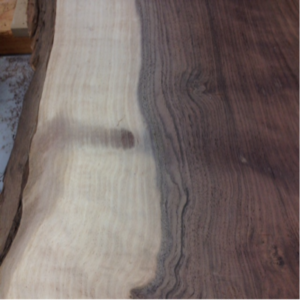Sticker Stain –
A Problem When Drying Lumber

Sticker Stain
One of the more common drying problems today is a dark area noted on dried, planed lumber. This discolored or stained area runs across the width of a piece of lumber and is at the same location where a sticker was located during drying. Typically, the stain is not seen in rough lumber: it is only evident after planning. The defect is known as sticker stain and is much easier to detect in “white woods.” The term white woods generally refers to spruce-pine-fir (SPF), beech, hard maple, cottonwood, etc. These are light colored woods as contrasted to oak, walnut, cherry, cedar, etc. Sticker stain can be more severe in some years than others. This is likely due to many factors but one of which is surely local weather. Prolonged high humidity will facilitate a wide array of surface stains and mold. My experience has shown me that another primary cause of sticker stain, and most other drying problems, is a lack of proper training of the kiln operators for drying white woods.
Basics of White Wood Drying
The primary cause of sticker stain is slow drying (less than 5% moisture content per day) at warm temperatures (50 to 130 F) when the lumber is above 40% moisture content. These slow drying conditions encourage a chemical reaction to proceed in the wood. As the lumber dries, the discoloration progresses but may not become evident until much later in the drying process (below 15% moisture content). The final discoloration is accentuated by temperatures over 150 F during the final steps of the drying schedule. However, the initial slow drying is the primary cause of sticker stain. Poor handling of the wood before drying begins can also lead to a high incidence of sticker stain. Poor handling includes long log storage in warm weather and holding freshly sawn lumber in a dead stacked (no stickers) bundle before stacking. It is important to recognize that sticker stain is not a fungal stain. However, the slow drying that results in sticker stain can also result in fungal staining if other conditions for fungal activity are present. Fungal stain can range from non-wood destroying surface stains such as blue or sap stain and mold to the wood-destroying brown and white rot fungi.
Treatment Options
Sticker discolorations are almost inevitable, but they can generally be eliminated with light surfacing of the dried wood. Control measures should be concentrated on drying procedures that will lessen the intensity and depth of the discolorations. These include using dry, narrow stickers or grooved stickers to reduce the contact area and starting the drying of green lumber as soon as possible. Dry-bulb temperatures should be moderate, and wet-bulb depressions should be sufficient for fast drying to avoid checking. There should be good air circulation of at least 200 ft/min across the load. Green boards should be chemically treated when sapwood-stain fungi or bacteria are contributing factors. Several products are available that can be sprayed applied or used as a dip treatment.
Meet the Author
Dr. Todd Shupe is the President of Wood Science Consulting, LLC. He is a well-recognized expert on wood forensics, wood preservation, wood decay and degradation, and wood species identification. He has a broad background in new product development, quality management, and marketing and sales in both the public and private sectors. For more information please visit DrToddShupe.com.
We welcome your comments below.
Thank you for visiting. We trust that you have enjoyed reading our articles.
Liked this post? Read more below or search for more topics . . .

